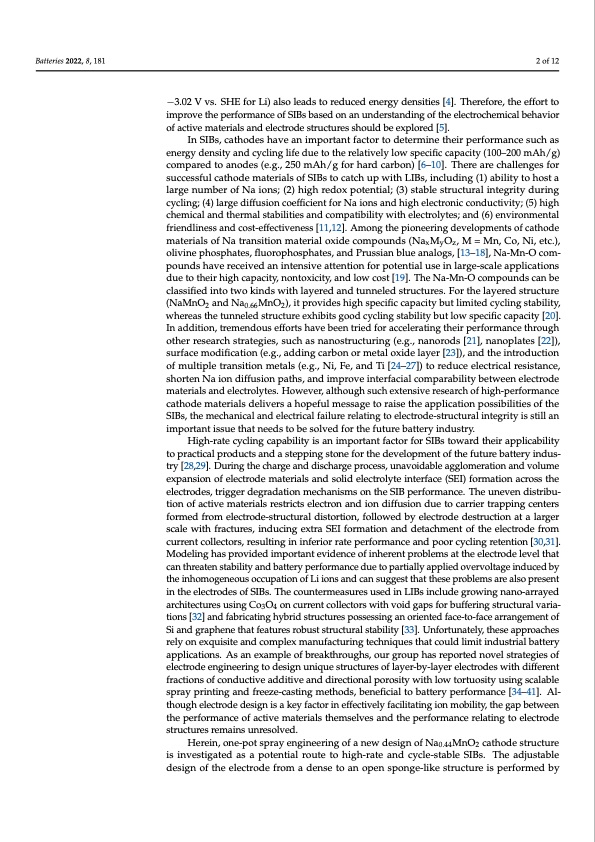
PDF Publication Title:
Text from PDF Page: 002
Batteries 2022, 8, 181 2 of 12 −3.02 V vs. SHE for Li) also leads to reduced energy densities [4]. Therefore, the effort to improve the performance of SIBs based on an understanding of the electrochemical behavior of active materials and electrode structures should be explored [5]. In SIBs, cathodes have an important factor to determine their performance such as energy density and cycling life due to the relatively low specific capacity (100–200 mAh/g) compared to anodes (e.g., 250 mAh/g for hard carbon) [6–10]. There are challenges for successful cathode materials of SIBs to catch up with LIBs, including (1) ability to host a large number of Na ions; (2) high redox potential; (3) stable structural integrity during cycling; (4) large diffusion coefficient for Na ions and high electronic conductivity; (5) high chemical and thermal stabilities and compatibility with electrolytes; and (6) environmental friendliness and cost-effectiveness [11,12]. Among the pioneering developments of cathode materials of Na transition material oxide compounds (NaxMyOz, M = Mn, Co, Ni, etc.), olivine phosphates, fluorophosphates, and Prussian blue analogs, [13–18], Na-Mn-O com- pounds have received an intensive attention for potential use in large-scale applications due to their high capacity, nontoxicity, and low cost [19]. The Na-Mn-O compounds can be classified into two kinds with layered and tunneled structures. For the layered structure (NaMnO2 and Na0.66MnO2), it provides high specific capacity but limited cycling stability, whereas the tunneled structure exhibits good cycling stability but low specific capacity [20]. In addition, tremendous efforts have been tried for accelerating their performance through other research strategies, such as nanostructuring (e.g., nanorods [21], nanoplates [22]), surface modification (e.g., adding carbon or metal oxide layer [23]), and the introduction of multiple transition metals (e.g., Ni, Fe, and Ti [24–27]) to reduce electrical resistance, shorten Na ion diffusion paths, and improve interfacial comparability between electrode materials and electrolytes. However, although such extensive research of high-performance cathode materials delivers a hopeful message to raise the application possibilities of the SIBs, the mechanical and electrical failure relating to electrode-structural integrity is still an important issue that needs to be solved for the future battery industry. High-rate cycling capability is an important factor for SIBs toward their applicability to practical products and a stepping stone for the development of the future battery indus- try [28,29]. During the charge and discharge process, unavoidable agglomeration and volume expansion of electrode materials and solid electrolyte interface (SEI) formation across the electrodes, trigger degradation mechanisms on the SIB performance. The uneven distribu- tion of active materials restricts electron and ion diffusion due to carrier trapping centers formed from electrode-structural distortion, followed by electrode destruction at a larger scale with fractures, inducing extra SEI formation and detachment of the electrode from current collectors, resulting in inferior rate performance and poor cycling retention [30,31]. Modeling has provided important evidence of inherent problems at the electrode level that can threaten stability and battery performance due to partially applied overvoltage induced by the inhomogeneous occupation of Li ions and can suggest that these problems are also present in the electrodes of SIBs. The countermeasures used in LIBs include growing nano-arrayed architectures using Co3O4 on current collectors with void gaps for buffering structural varia- tions [32] and fabricating hybrid structures possessing an oriented face-to-face arrangement of Si and graphene that features robust structural stability [33]. Unfortunately, these approaches rely on exquisite and complex manufacturing techniques that could limit industrial battery applications. As an example of breakthroughs, our group has reported novel strategies of electrode engineering to design unique structures of layer-by-layer electrodes with different fractions of conductive additive and directional porosity with low tortuosity using scalable spray printing and freeze-casting methods, beneficial to battery performance [34–41]. Al- though electrode design is a key factor in effectively facilitating ion mobility, the gap between the performance of active materials themselves and the performance relating to electrode structures remains unresolved. Herein, one-pot spray engineering of a new design of Na0.44MnO2 cathode structure is investigated as a potential route to high-rate and cycle-stable SIBs. The adjustable design of the electrode from a dense to an open sponge-like structure is performed byPDF Image | Cathode Electrodes High-Rate Cycle-Stable Na-Ion Batteries

PDF Search Title:
Cathode Electrodes High-Rate Cycle-Stable Na-Ion BatteriesOriginal File Name Searched:
batteries-08-00181-v3.pdfDIY PDF Search: Google It | Yahoo | Bing
Salgenx Redox Flow Battery Technology: Salt water flow battery technology with low cost and great energy density that can be used for power storage and thermal storage. Let us de-risk your production using our license. Our aqueous flow battery is less cost than Tesla Megapack and available faster. Redox flow battery. No membrane needed like with Vanadium, or Bromine. Salgenx flow battery
| CONTACT TEL: 608-238-6001 Email: greg@salgenx.com | RSS | AMP |